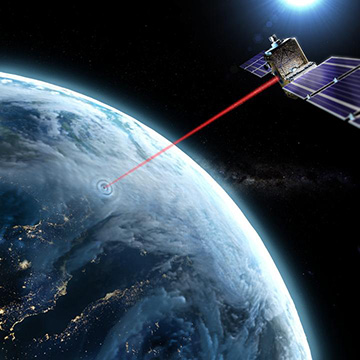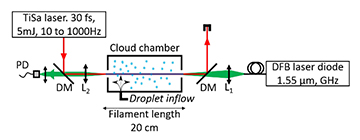
[Image: UNIGE, Xavier Ravinet]
Laser-based communication between orbiting satellites and Earth’s surface offers the prospect of significantly increasing space-to-ground data rates, and also constitutes a key element in future plans for secure worldwide quantum communication networks. But these free-space optical links between Earth and space face a persistent nemesis—atmospheric clouds, which scatter optical energy and can quickly gum up the signal encoded in the thin laser beam carrying the information.
A research team at the University of Geneva, Switzerland, now proposes an answer to the quandary: Use another laser to poke a hole in the clouds, clearing a narrow path for a cloud-free laser transmission (Optica, doi: 10.1364/OPTICA.5.001338).
Long-standing quandary
Builders of free-space optical links have already tried out a number of methods to get past the cloud quandary. One such approach has been adaptive optics, which involves computationally re-shaping the wavefront to compensate for atmospheric scattering effects. But the most common solution is simply to create a large network of ground stations, so that communications can take place at locations where the sky is generally free of clouds. That’s an expensive and awkward fix, and still not much good in areas that are overcast much of the time.
Several efforts in the past have also attempted to clear clouds using lasers. In the late 1970s and 1980s, for example, the military attempted to use powerful continuous-wave CO2 lasers to get rid of fog by vaporizing and shattering suspended water droplets—a method that proved impractical because it required prodigious amounts of laser power.
More recently, researchers have investigated using so-called laser filaments as a way to pierce the clouds. These filaments arise due to nonlinear self-focusing and plasma-generation effects when high-intensity, ultra-short laser pulses propagate through the atmosphere. The result is essentially a self-generated waveguide for the laser energy, typically around a tenth of a millimeter in diameter, that can extend hundreds of meters through the air. But the terawatt-class femtosecond lasers needed to produce the filamentation effect sport repetition rates only on the order of kilohertz, too slow for high-bit-rate free-space optical communication.
A two-laser approach
The Geneva team, led by OSA member Jean-Pierre Wolf, decided to try out what the group calls a “radically new approach”: Using one high-peak-power laser to muscle suspended atmospheric water droplets out of the way, and another, higher-bandwidth laser to carry a signal through the channel cleared by the first laser.
It turns out that when a high-peak-power femtosecond pulse courses through the air and gives rise to a laser filament, the plasma generation creates a shock wave that propagates in front of the filament. The shock wave shoves the water vapor and other particles out of its path, clearing a reduced-density channel in the air that’s significantly wider than the narrow cross-section of the laser filament itself—and that can remain clear of water vapor for 0.1 to 1 milliseconds after the shock wave passes. If the laser can pump out additional pulses at a rate faster than that time window, the hole in the clouds can be kept open longer.
The Geneva team reasoned that, by coupling a second laser, tuned for broadband communications, into the wide particle-free channel created by the first, the channel could form a conduit for Earth-to-satellite communications—with no practical limit on data bandwidth, and with no cloud-cover constraint on signal timing. “All you then need to do is keep the laser beam on the cloud and send the laser that contains the information at the same time,” the study’s lead author, Guillaume Schimmel, noted in a press release. “It then slips into the hole through the cloud and allows the data to be transferred.”
Cloud-chamber model
The researchers used a Ti:sapphire laser to punch a hole in a model cloud, and a counterpropagating continuous-wave telecom laser to carry a signal through that channel. PD, photodiode; DM, dichroic mirror; DFB, distributed feedback. [Image: G. Schimmel et al., Optica, doi: 10.1364/OPTICA.5.001338] [Enlarge image]
The team tested the approach by sending 30-fs pulses from a 5-mJ, 800-nm Ti:sapphire laser through a laboratory-scale cloud chamber, which had been charged with water droplets in a size distribution designed “to simulate realistic cloud conditions,” and with droplet densities 100 times those of a typical cumulus cloud. A counterpropagating distributed-feedback laser at telecom wavelengths served as the data carrier in the setup.
The researchers found that they were indeed able to open a clear communication channel in the cloud chamber. When the pulsed, channel-clearing laser was operated at low repetition rates, the communications throughput was modest at best, as the hole in the model cloud tended to close up too fast to be useful. But once repetition rates reached more than 200 Hz, the channel carved in the cloud-chamber fog reached a quasi-steady state, and optical data transmission via the coupled telecom laser took a 30-fold jump.
From lab to sky
The researchers point out that the tests, while across only a laboratory length scale, involved densities of particles several orders of magnitude greater than those in real clouds, providing “an optical density comparable to realistic atmospheric conditions,” according to the study. But translating success in the cloud chamber to atmospheric distances will involve some additional requirements. One will be higher-energy lasers than the 5-mJ model used in the proof of concept; to poke holes in the clouds across kilometer distances will require lasers with energies on the order of 100 mJ to 1 J that can fire at kilohertz repetition rates. Such lasers, the paper notes, are “currently in development.”
Keeping the telecom laser from spreading and diverging outside of the temporary path cleared by the pulsed laser is another challenge over the long distances required for free-space optical communication. The team suggests that using a mid-IR pulsed laser to clear the path, rather than the near-IR laser used in the proof of concept, could open up a much wider channel to accommodate the data-carrying telecom beam.
The team believes these are surmountable obstacles, and is working on scaling up the system to realistic ranges. “We're talking about possible global implementation by 2025,” team leader Wolf noted in a press release accompanying the work. “Our idea is to be ready and to allow countries that are overcast to have this technology.”

